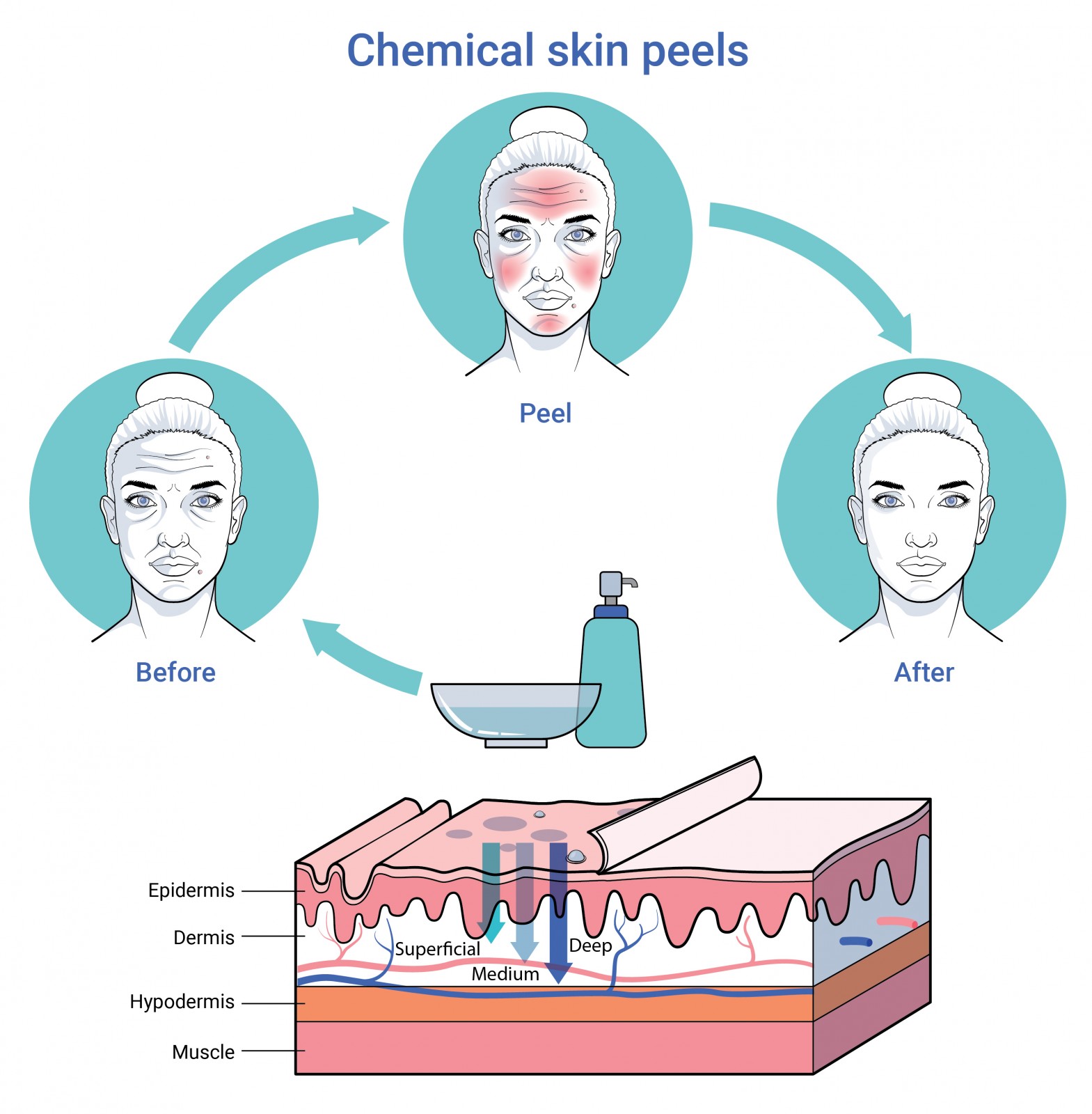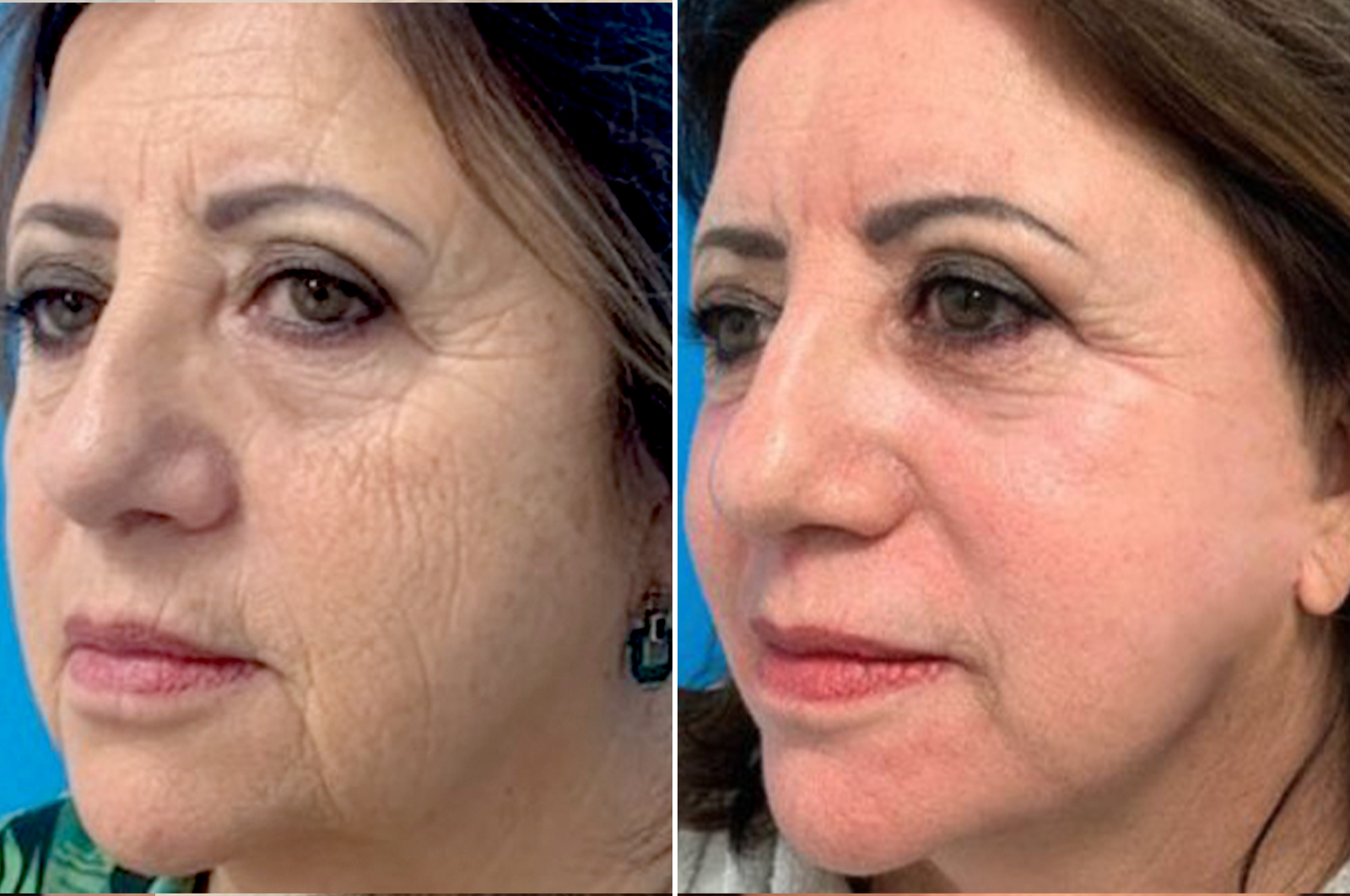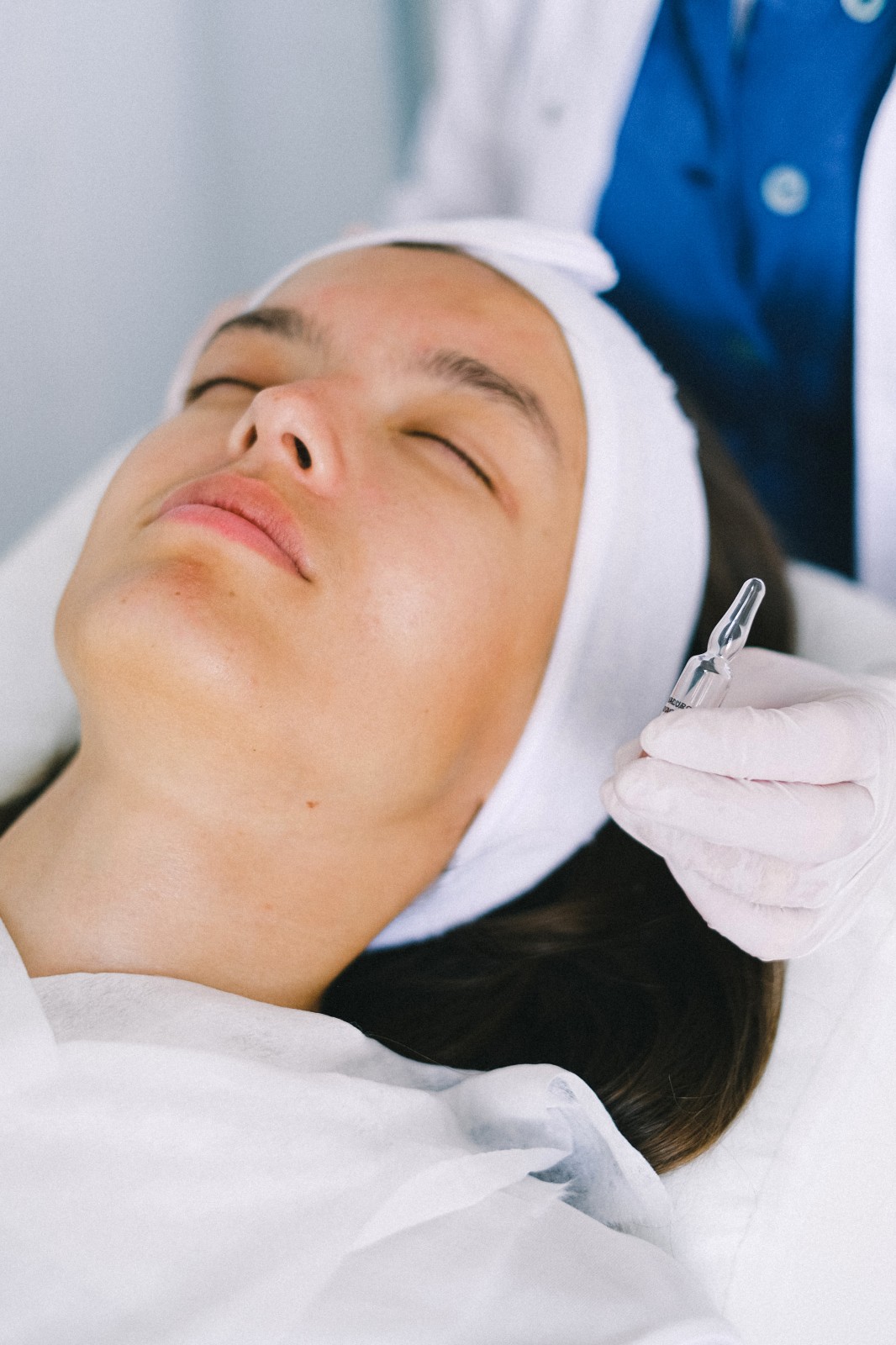Chemical peels
Table of contents:
Types of chemical peels
A chemical peel is a solution applied to the face to remove dead skin cells and stimulate the growth of new cells. The aim is to improve the appearance of the skin – for example, by reducing age spots and evening out skin tone.
In general, 3 types can be distinguished according to penetration levels:
- Phenol peels (deep penetration of the skin layers, usually performed by a doctor)
- TCA peels (medium penetration of the skin layers, usually performed by an aesthetic practioner or doctor)
- Peels using natural ingredients (superficial penetration of the skin layers, usually performed by an aesthetic practioner or certified beautician)
At our clinic, phenol peels and TCA peels are performed.
Attention! To achieve the best results, it is very important that you strictly follow all instructions before and after the treatment.

The phenol peel (deep)
What is a phenol peel of the face?
Compared to natural or superficial peelings, a phenol peeling penetrates much deeper in the upper skin layer (papillary dermis). It removes damaged and dead skin cells to make room for new skin cells. At the same time, the underlying dermis is stimulated to produce new cells - a true boost for your collagen and elastin production!
Anyone suffering from skin ageing with fine lines, hyperpigmentation, sun damage, unevenness or even small (acne) scars can have their skin structure improved with a chemical peel using phenol. It often gives an smoothing, lifting and/or tightening effect. This chemical peel is often combined with other treatments such as lipofilling or a facelift.
Procedure - How does a phenol peel work?
- First, a treatment plan is drawn up. Your doctor will discuss with you what you specifically want to address with this peel, what the options are, how many sessions you may need and what you can expect.
- During the treatment, your skin will first be cleansed. We recommend that you do not wear make-up while being treated.
- Then the peel liquid is applied with or without local anaesthesia. Depending on the depth of the peeling, one or more layers are applied. The first 15 seconds you may experience a burning sensation. This feeling will slowly disappear. Should you experience lasting discomfort, do not hesitate to mention this to your doctor during the treatment.
- A session lasts approximately 30 to 60 minutes. Normally, you can go home immediately afterwards and you will be given painkillers.
- The more superficial the condition, the fewer treatments are required. Deep phenol peelings often require only one treatment.
- The final result of this treatment is best seen after 4 months and remains visible for several years.
Advantages of a phenol peel
A phenol peelings penetrates the barrier where pigment is formed. It therefore tackles the following issues:
- Pigment spots
- UV or sun damage
- Dull complexion
- A coarse skin structure becomes visibly and tangibly smoother. As a result, fine lines or uneven skin texture become less visible.
- Small scars can be evened out to a great extent.
- After a few months you will even notice a lifting and tightening effect. This is due to the stimulation of collagen and elastin production in the skin.

Disadvantages or complications of a phenol peel
- Depending on which skin problem you want to address and how deep you want the peel to work, you may need several sessions.
- During treatment, you may experience a burning, uncomfortable sensation.
- After treatment, your face may peel, which can last up to 10 days.
- Infection can always occur, as with any treatment or procedure. You should therefore carefully follow the aftercare instructions given by your doctor.
- This treatment can only be performed between October and April (in order to avoid sun damage during the summer).
Recovery - What can you expect after a phenol peel?
- During the treatment you may experience a burning sensation. This diminishes during the treatment.
- The first days after the phenol peeling, the skin may be taut, painful, red or slightly swollen. This depends on the intensity of the treatment.
- From day 3 your face will start to peel, which can last up to 10 days. Expect scabs, itching, peeling etc. Try not to touch your skin and let the skin come off naturally. Do not cleanse your skin until 10 to 14 days after the treatment. You will receive corresponding instructions. Also be careful when cleaning your skin and use an soothing and disinfectant cream to moisturise the skin.
- We recommend avoiding direct sunlight for the first three months and using a sun screen with a high sun protection factor (e.g. SPF 50).
- As your skin will be sensitive to sunlight, we only carry out this treatment between October and April to avoid sun damage during the summer.
The TCA peel (medium)
Radiant skin starts from within. Thanks to a chemical peeling, you can smooth out unevenness in the skin, small scars, fine lines, blemishes etc. and stimulate cell renewal so that your skin starts to glow again. In our clinic, we specifically offer TCA peels which penetrate the skin layers at a medium level.
What is a TCA peel?
Trichloroacetic acid (TCA) peels are a type of chemical peel used to treat a wide range of skin problems, including signs of ageing, sun damage, hyperpigmentation and scarring. TCA peels are usually performed at medium strength by an aesthetic doctor and require some recovery time, but offer significant improvements in skin texture.
Who is a suitable candidate for a TCA peel?
Anyone who suffers from the following:
- Acne (not active) and other micro scars
- Discolouration of the skin
- Hyperpigmentation
- Sun damage
- Age spots
- Melasma
- Very fine lines
- Coarse pores
- Dull and sallow skin
The strength of the peel depends on the condition you want to treat. A light peel can remove the top layer of skin to treat sun damage and age spots. For the treatment of moderate wrinkles and deep scars, a stronger peel may be necessary to remove more layers of skin.
We do not recommend a TCA peel in the following cases:
- If you have a history of abnormal skin scarring.
- If you have a naturally dark complexion or skin tone.
- If you suffer from extra pigmentation in scars.
- If you have used certain acne treatments in the past year.
- Skin disorders or medications that make the skin more sensitive than usual.
Before starting a course of treatment, you will have an extensive consultation with our aesthetic doctor. Only after this consultation can a treatment be started.
How does a TCA peeling work?
Before treatment
First, you will have an extensive consultation with the aesthetic doctor. You will be informed about the effects, the composition of the peel and what you can expect after the treatment. In addition, the possible complications and the aftercare that must be followed very carefully will be discussed. This is the only way to achieve the best results.
- If a cold sore occurs on the day of treatment, the appointment must be rescheduled.
- When using botox and/or fillers, there should be at least 2 weeks between these treatments.
- When using acne medication (think of Roaccutane), no treatment may take place for at least 6 months.
- Stop using retinol creams or serum / vitamin A acid creams 5 days before the treatment.
- For men, it is advisable not to shave the face within 24 hours of the treatment.
- The treatment may not be performed on sun-tanned skin; please ensure that there is a minimum of 4 weeks in between treatments.
- The treatment may not be performed during pregnancy and/or while breastfeeding.
During the treatment
- During your session, the aesthetic doctor will apply a TCA solution on your skin. The acid then penetrates through the upper layers of your skin to remove dead skin cells. In addition, this stimulates the growth of new, healthy skin cells and collagen.
- You will experience a tingling sensation. If you experience any pain, inform the doctor treating you immediately.
- When your peeling is complete, we will clean your skin and apply a moisturiser to intensely nourish your skin.
- Most treatments last about 30 minutes, but individual cases may vary depending on the skin problem you want to address.
After the treatment
- You will be given the necessary aftercare instructions and tips to take optimum care of your skin.
- Your skin may look red or slightly swollen after the treatment. This may last a few days. Daily activities can be continued as usual after the treatment.
- From day 3 to 5 or 6 the skin will start to exfoliate and be extra vulnerable. Allow the skin to loosen naturally and do not pull at the loose pieces of skin as this may cause scarring.
- Be careful when wearing mouth masks.
- Take care of your skin with moisturising creams, both day and night.
- Protect your skin from the sun by using sunscreen.
- Avoid using make-up, direct sunlight, tanning beds, strenuous activities or swimming pools for six weeks. Wait until your skin has completely peeled off.
 TCA peeling
TCA peeling
Benefits
- It can minimise fine lines such as crow's feet and expression lines.
- It evens out coarser skin texture (e.g. large pores).
- It can repair sun damage.
- It is a good treatment for acne scars.
- Effective against melasma.
- It fades pigmentation spots, age spots or freckles.
- Suitable for most skin types, provided the correct proportions of ingredients are used. Darker skin types may react more sensitively.
Possible disadvantages, complications or side effects
- Redness, crusting and swelling for a few weeks. The normal healing of a chemical peel is accompanied by redness of the treated skin. After a medium or deep chemical peel, the redness can last for several months.
- Scarring. In rare cases, chemical peels can cause scarring - usually in the lower part of the face. Antibiotics and steroid medications may be used to soften the appearance of these scars.
- Changes in skin colour. A chemical peel may cause the treated skin to become darker than normal (hyperpigmentation) or lighter than normal (hypopigmentation). Hyperpigmentation is more common after superficial peels, while hypopigmentation is more common after deep peels. These problems are more common in people with coloured skin and can sometimes be permanent.
- Infection. A chemical peel can lead to a bacterial, fungal or viral infection, such as a flare-up of the herpes virus - the virus that causes cold sores.
How long do the results last?
- The results of chemical TCA peels last from about six months to two years.
- Deep-seated skin problems may require several sessions.
- If you take good care of your skin and use anti-ageing products regularly, you can extend the duration of the results.
- Excessive peeling and removal of the protective layer of skin is not recommended.
We are doing our very best to keep this information up-to-date. In case you see anything that no longer seems accurate, or in case you have a question, please fill out the form below.
